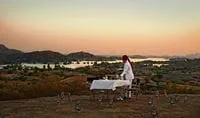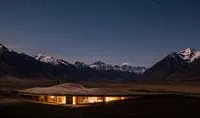Our guide to Cambodia
Captivating and colourful, Cambodia offers visitors a wealth of experiences and an insight into one of the world’s most fascinating histories.

From one of Asia’s earliest civilisations during the Angkorian period to the French colonial era and from the tragic years under the Khmer Rouge to a country that is now full of positivity and growth, Cambodia has had a varied and somewhat turbulent time. Nowadays it’s one of Asia’s most celebrated destinations packed full of other-worldly experiences.
Explore its temples tangled in jungle at dawn, experience Angkor Wat soaring from the dusty plains at sunrise, navigate its sleepy colonial towns, luxuriate on its glistening beaches and enjoy welcoming smiles in its pristine villages. It’s packed full of things to do and is ideal for families and couples alike. Stop here for 3 or 4 days as part of a longer tour through Indochina, or spend 10-14 days seeing it as a standalone destination in-depth. Whatever you choose to do, you can be sure to succumb to its charm.
Why Cambodia?
The Angkor Archaeological Park, home to Angkor Wat and Angkor Thom is like nowhere on earth and can only be compared to the majesty of The Taj Mahal or Machu Picchu. Crumbling temples are ensconced in luminous jungle as others soar from the ground. As the location for Tomb Raider, the area is perfect for families as the temples are ripe for adventurous exploration on foot or by bicycle. The coast is also fringed by untouched beaches and warm waters, so Cambodia is also a fantastic destination for those wanting to avoid more built up beach locations found in neighbouring countries. To us the real draw of Cambodia is its people. Despite such a tragic history, their spirit and charm is beyond compare and you’ll find yourself instantly and warmly welcomed.
When is the best time to visit Cambodia?
Cambodia is essentially a year round destination that’s warm throughout the year. Unlike many countries in Asia it has a fairly simple weather system with just two seasons; dry season that runs from October to April and the so called wet season that runs from May to September. Read more about the best time to visit.
How do you get to Cambodia?
For most, flying to Cambodia will not be direct but getting there is still very straightforward. We can simply arrange your flights via one of the Asian hubs. From Bangkok, from it’s just over an hours’ hop over to Phnom Penh or Siem Reap (close to the temples of Angkor, including Angkor Wat). There are also domestic flights from Siem Reap to Sihanoukville nowadays, which makes access to the beach areas really easy.
How to get around Cambodia?
This very much depends on your itinerary and how much time you have. Many choose to fly between Siem Reap and Phnom Penh as this is a short and easy hop, saving a day in a car. It’s also possible to fly to Sihanoukville from Siem Reap as well. For shorter journeys we often find it better to go overland by air-conditioned vehicle with a private driver, which we love, as you are able to see and experience the landscape en-route. The most common journeys are Siem Reap or Phnom Penh to the colonial town of Battambang, or from Phnom Penh to Sihanoukville or Kep on Cambodia’s coast. The road network is constantly improving, making this easier.
What are the main highlights of Cambodia?
Siem Reap, the entry point to the Angkor Archaeological Park is what draws most people to Cambodia; the area is the country’s undisputed highlight. UNESCO protected, the area is home to some of the world’s most significant temple structures and remains of towns and villages that date back between the 9th and 15th century. It really offers an other-worldly experience and is truly beyond compare. There are numerous ways to enjoy the area depending on your interests; for families we’ve designed treasure hunts, cycling routes and village experiences and for history enthusiasts we’ve sourced specialists to get you behind the scenes of these ancient monuments, providing an in-depth view.
Phnom Penh, Cambodia’s capital, is also not to be missed. Sitting on the banks of the mighty Mekong River, the city is one of Asia’s fastest growing capitals and has an arty ambiance with great boutiques, markets and restaurants. It also provides a captivating insight into Cambodia’s rule under the Khmer Rouge. We’ve crafted some fantastic experiences to make sure you learn about this turbulent period in the right way.
To the west of Phnom Penh, Cambodia’s coastline is also a major draw. Undeveloped, sleepy and pristine, the areas of Kep as well as the island of Koh Rong provide an idyllic and unique respite after a busy touring itinerary. The hotels here are really impressive.
For those with more time we highly recommend the sleepy and charming town of Battambang. The area is studded with fantastic temples and a patchwork of paddy fields and is perfect for those who want to escape the crowds during high season.
If you are looking to really get more off the beaten track then look no further than the far north and east of Cambodia. Remote, wild and untouched, this part of Cambodia is great for intrepid families looking to explore. Visit tribal communities, elephant conservation projects, dramatic waterfalls and enjoy the scenery by zip-line or on the back of a quad bike. Accommodation is simple here, and journeys are long, but we think it’s immensely rewarding. Mondulkiri in particular is one of our favourite regions; offering large tracts of wilderness. It’s also home to half of Cambodia’s elephant population.
Accommodation
Accommodation in Cambodia varies greatly, from luxurious 5* retreats in Siem Reap to simple boutique lodges in the far north and east. We spend a lot of time researching and testing the properties we recommend to ensure where you stay is as comfortable as possible. In general, the more remote you get the more simple the properties become.
Luxury hotels in Cambodia
Luxurious 5* hotels in Cambodia are at their best in Siem Reap. Amansara is one of our favourites with understated luxury at its core. Phum Baitang offers paired-back natural luxury whilst La Residence d’Angkor offers more traditional boutique comfort. In Phnom Penh look no further than historic Raffles Le Royal that dates back to 1929.
Classic itineraries
We always tailor-make our itineraries, but have created a few suggested itineraries which can of course be adapted to suit you and your interests. Discover Siem Reap and the beauty of Angkor Wat, the delicious cuisine of Phnom Penh before heading to the paradisal shores of Krabey Island on the Cambodian coast with our Epic Cambodia itinerary. Alternatively, combine Cambodia with other countries in the region, with our Cambodia & Laos Uncovered, Exceptional Vietnam and Cambodia or our Epic Indochina tours Please remember that every itinerary is designed from scratch and can be completely designed for you.
Cambodia for families
From the ruined forest temples of Angkor to the remote tribes in Mondukiri and from the glorious beaches on the west coast to elephant projects in the far-east, Cambodia is an excellent destination for families. To make the most of it we’ve created extraordinary as well as educational experiences for all the family to enjoy. Many of the hotels are also well equipped to take families as well, with lots of family villas and interconnecting rooms available. Talk to our specialists about your children’s interests and your exact requirements, so that we can design the best thing for you and your family.
Cambodia for honeymooners
With a wealth of unique and luxurious accommodation, private island escapes and one in a lifetime experiences such as temple breakfasts, gourmet meals surrounded by paddy fields and helicopter journeys to remote locations, Cambodia makes a fantastic option for honeymoons. We can craft a tour just in Cambodia but we can also combine it with Vietnam, Laos and/or Thailand for something truly spectacular.
Unique experiences
We have crafted and created some incredible experiences so that you make the most of your time in Cambodia and get beyond the obvious. We do everything we can to avoid contrived and touristy experiences so that you see the authentic and real Cambodia and get to the heart of real communities. Examples include kayaking on Tonle Sap Lake, cycling through the temples of Angkor, a foodie tour on the back of a vintage Vespa, exploring Angkor Wat with experts such as Dr Damian Evans and taking a helicopter to remote corners of the country. It’s also possible to meet with one of the survivors of S21 and enjoy a private dinner surrounded by paddy fields. We really feel we offer some of the most unique and exclusive experiences in Cambodia and have taken great lengths to make sure you do this in style.
Cambodia’s cuisine
Cambodian cuisine is as unique as its history and we highly recommend getting involved. It tends to be less spicy than what is found in Laos and Thailand and it arguably has more similarities with Vietnam and China. Lots of Cambodia’s dishes are cooked in a single pot or wok over a stove, such as fish amok, one of the country’s most famous dishes. You’ll find everywhere and it includes a local herb known as slok ngor, along with fresh coconut milk, lemongrass, turmeric root, garlic and galangal. Khmer Red Curry is another speciality; less spicy than in neighbouring countries, this coconut based dish can be served with beef, chicken or rice. Thanks to the French, you’ll still find baguettes everywhere as well. To make the most of Cambodia’s comforting cuisine, we recommend our Dine around Phnom Penh experience, our Foodie Vespa Adventure or Private Temple Dinner.
Festivals and holidays
Cambodians love celebrating and have more public holidays than most countries on earth! Public holidays in Cambodia centre around four main themes; traditional farming celebrations, Buddhist festivals, the Royal Family and those recognizing independence from France and the Khmer Rouge.
Arguably the most important festival is the Khmer New Year (April 14-16), which sees Cambodian families returning to their hometowns around the country. It marks the end of the long dry season, the beginning of the rainy season and the end of the harvest; put simply it celebrates abundance and food. During this time families will place small shrines outside their houses that are decorated with candles and infused with incense that they burn all day. The ritual washing of Buddha statues, the elderly and oneself is also highly important, intended to bring luck for the rest of the year. From a travel perspective, we typically suggest that guests avoid the week of New Year celebrations, as many sites can be quite crowded with domestic celebrations.
The Water Festival is arguably the most visually impressive that’s typically held in October or November. The Water Festival celebrates the ancient Cambodian navy of King Jayavarman VII (builder of Ta Prohm, Angkor Thom and Bayon). The timing of the celebration coincides with the famed reversal of flow of the Tonle River; the only river in the world to flow backwards! Boat races are held throughout the country, with the largest being in Phnom Penh. Siem Reap’s racing, which passes through the centre of town, is also a fantastic spectacle and highly recommended. During this time riverside streets are closed to vehicles and the celebrations spill into the streets, with open air concerts being an important aspect. In the evenings, families gather at the river to float hundreds of small candle-lit paper boats down the river.
Temples of Cambodia
For more information about Cambodia’s magnificent temples and monuments, take a look at our guide. Here we explain where to go, when to go and some of our beautifully designed experiences to help you make the most of them.
Combinations with other countries
Cambodia combines brilliantly with Vietnam, Laos and Thailand.
Similar destinations that you might like too
Call us on 212 372 7009 to start planning your holiday
Why Scott Dunn?
Unique to You

- We listen to your travel goals and craft unique trips that are bespoke to you.
- We’re with you every step of your life’s travel journey, from honeymoons to family trips and beyond.
Seamless Service

- Global offices in the UK, US, and Singapore for 24/7 seamless service.
- We offer flexibility if your plans change so you can book with confidence and peace of mind.
Carefully Curated Collection

- We’ve curated an elevated collection of accommodation, experiences, and guides.
- Committed to fostering close global relationships to continue bringing you unique experiences.
Luxury in Every Sense

- We deliver a sense of luxury that matters most to you.
- Awarded Condé Nast Traveller’s Top Travel Specialists in the World 12 years in a row.




